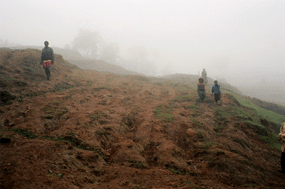Precipitation
Polynominal precipitation-elevation-relationship given in the rainfall model
During the rainy seasons, the Gina River catchment is exposed to the wind coming from western to north-western direction (Griffiths 1972, citied in Beck et al. 2004). Advection of water rich air masses along the graben flank causes increased precipitation in the highland areas compared to the lowland areas (air is forced to rise). This explains the distinct relation between precipitation and elevation as about 80 % of the annual rainfall appear during the rainy season (Beck et al. 2004, 52). The effect of advection due to upslope lifting stops in tropical regions – in contrast to nontropical regions - below the mountain tops (Nieuwolt 1977, citied in Beck et al. 2004). In the Gina River catchment this point appears in 2780 m a.s.l. (Beck et al. 2004, 52). Above this point precipitation does not increase with altitude.
Due to the lack of available data the behaviour of the orographic rain effect in the Gina River catchment cannot be controlled. Yet the given theoretical backround provides an informative base to support the polynominal precipitation-elevation-relationship. The data situation is, however, a possible source of error (Beck et al. 2004).
Rainfall variability
The central Ethiopian highlands are characterised by a high precipitation variability (Osman 2001, citied in Beck et al. 2004). Consequently, a significant amount of rain is falling in a low number of extreme precipitation events. This leads to an high erosion capacity of water. As the amount of water in general increases by elevation, most of the runoff has a long distance. But it is to be considered that the recurrence analysis although a feasible approach does not provide data of high reliability (Beck et al 2004).
Discussion of the soil investigation results are presented on the following page.
